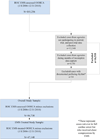Out-of-hospital cardiac arrest survival improving over time: Results from the Resuscitation Outcomes Consortium (ROC)
- PMID: 25676321
- PMCID: PMC4433591
- DOI: 10.1016/j.resuscitation.2015.02.003
Out-of-hospital cardiac arrest survival improving over time: Results from the Resuscitation Outcomes Consortium (ROC)
Abstract
Background: Out-of-hospital cardiac arrest (OHCA) remains a leading cause of death and a 2010 meta-analysis concluded that outcomes have not improved over several decades. However, guidelines have changed to emphasize CPR quality, minimization of interruptions, and standardized post-resuscitation care. We sought to evaluate whether OHCA outcomes have improved over time among agencies participating in the Resuscitation Outcomes Consortium (ROC) cardiac arrest registry (Epistry) and randomized clinical trials (RCTs).
Methods: Observational cohort study of 47,148 EMS-treated OHCA cases in Epistry from 139 EMS agencies at 10 ROC sites that participated in at least one RCT between 1/1/2006 and 12/31/2010. We reviewed patient, scene, event characteristics, and outcomes of EMS-treated OHCA over time, including subgroups with initial rhythm of pulseless ventricular tachycardia or ventricular fibrillation (VT/VF).
Results: Mean response interval, median age and male proportion remained similar over time. Unadjusted survival to discharge increased between 2006 and 2010 for treated OHCA (from 8.2% to 10.4%), as well as for subgroups of VT/VF (21.4% to 29.3%) and bystander witnessed VT/VF (23.5% to 30.3%). Compared with 2006, adjusted survival to discharge was significantly higher in 2010 for treated cases (OR = 1.72; 95% CI 1.53, 1.94), VT/VF cases (OR = 1.69; 95% CI 1.45, 1.98) and bystander witnessed VT/VF cases (OR = 1.65; 95% CI 1.36, 2.00). Tests for trend in each subgroup were significant (p < 0.001).
Conclusions: ROC-wide survival increased significantly between 2006 and 2010. Additional research efforts are warranted to identify specific factors associated with this improvement.
Keywords: Emergency Medical Services (EMS); Out-of-hospital cardiac arrest (OHCA); Resucitation.
Copyright © 2015 Elsevier Ireland Ltd. All rights reserved.
Conflict of interest statement
None.
Figures
References
-
- Go AS, Mozaffarian D, Roger VL, et al. Executive summary: heart disease and stroke statistics – 2014 update: a report from the American Heart Association. Circulation. 2014;128 - PubMed
-
- Sasson C, Rogers MA, Dahl J, Kellermann AL. Predictors of survival from out-of-hospital cardiac arrest: a systematic review and meta-analysis. Circ Cardiovasc Qual Outcomes. 2010;3:63–81. - PubMed
-
- Hazinski MF, Nadkarni VM, Hickey RW, et al. Major changes in the 2005 AHA Guidelines for CPR and ECC: reaching the tipping point for change. Circulation. 2005;112:IV206–IV211. - PubMed
-
- Hazinski MF, Nolan JP, Billi JE, et al. Part 1: Executive summary: 2010 International Consensus on Cardiopulmonary Resuscitation and Emergency Cardiovascular Care Science With Treatment Recommendations. Circulation. 2010;122:S250–S275. - PubMed
-
- Sayre MR, Berg RA, Cave DM, et al. Hands-only (compression-only) cardiopulmonary resuscitation: a call to action for bystander response to adults who experience out-of-hospital sudden cardiac arrest: a science advisory for the public from the American Heart Association Emergency Cardiovascular Care Committee. Circulation. 2008;117:2162–2167. - PubMed
Publication types
MeSH terms
Grants and funding
- U01 HL077866/HL/NHLBI NIH HHS/United States
- U01 HL077871/HL/NHLBI NIH HHS/United States
- CAPMC/ CIHR/Canada
- HL077867/HL/NHLBI NIH HHS/United States
- 5U01 HL077863/HL/NHLBI NIH HHS/United States
- HL077887/HL/NHLBI NIH HHS/United States
- U01 HL077881/HL/NHLBI NIH HHS/United States
- HL077873/HL/NHLBI NIH HHS/United States
- U01 HL077872/HL/NHLBI NIH HHS/United States
- HL077871/HL/NHLBI NIH HHS/United States
- HL077881/HL/NHLBI NIH HHS/United States
- HL077908/HL/NHLBI NIH HHS/United States
- U01 HL077887/HL/NHLBI NIH HHS/United States
- U01 HL077885/HL/NHLBI NIH HHS/United States
- U01 HL077863/HL/NHLBI NIH HHS/United States
- U01 HL077908/HL/NHLBI NIH HHS/United States
- HL077872/HL/NHLBI NIH HHS/United States
- HL077866/HL/NHLBI NIH HHS/United States
- U01 HL077873/HL/NHLBI NIH HHS/United States
- U01 HL077867/HL/NHLBI NIH HHS/United States
- HL077885/HL/NHLBI NIH HHS/United States
LinkOut - more resources
Full Text Sources
Other Literature Sources
Medical




